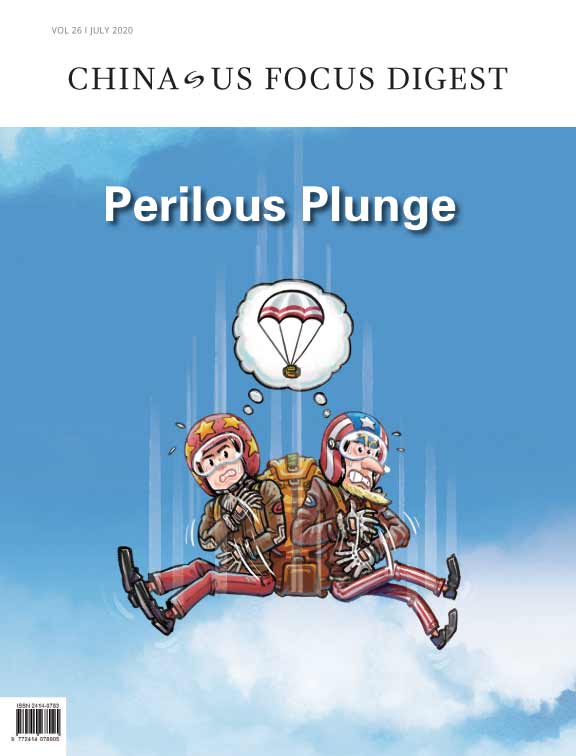
With China-U.S. relations at a crucial crossroads, what will happen next? This is a huge question for all countries.
Before my visit to the United States in 2000 (which was also a presidential election year), then-U.S. Ambassador to China Joseph Prueher invited me to the embassy in Beijing, where I was interviewed by The Associated Press and other American media outlets. I said that despite progress, China-U.S. relations were not good enough.
A reporter asked: How will you know that China-U.S. relations have improved? I answered: “When presidential candidates no longer resort to China-bashing to win votes in U.S. general elections, bilateral ties will reach a fresh stage.”
I’ve always felt keenly that unfamiliarity and misunderstandings between the two countries’ people are a major stumbling block.
This year will see another U.S. general election. I came across a political cartoon in which both the Republican and Democratic parties were shooting darts at China. The political attitudes that lead cartoonists to make such observations have driven a dramatic rise in negative opinions about China among members of the American public, as well as a surge in their nationalist feelings.
Since the start of the trade war in 2018, China has participated in multiple rounds of negotiations with the U.S. with great sincerity and honesty. The phase one negotiations came to a successful close in January, yet the U.S. side continues to attack China as its most significant rival.
This posture arose in December 2017, when the U.S. administration issued its U.S. National Security Strategy identifying China as a major strategic competitor and primary rival. In June 2019, the U.S. Defense Department released its Indo-Pacific Strategy Report, which targeted China as a primary national security concern. In May, the White House published a policy stance — United States Strategic Approach to the People’s Republic of China — claiming that China is launching fierce challenges to the economy, values and national security of the U.S. Such moves indicate that the U.S. is actively laying a Thucydides trap — a scenario in which a rising power and an established one end up in war.
In 2017, Harvard University Professor Graham Allison published the book “Destined for War,” which will have a Chinese translation soon. But Chinese readers don’t believe China and the U.S. will repeat the historical wars for dominance. Yet hawkish forces in the U.S. say their country’s main threat is not terrorism but a sovereign country. Post-Cold War America needs a new enemy, it seems, and neoconservative forces in the U.S. want to push China-U.S. relations into the trap.
Click to read the latest China-US Focus Digest Vol 26 here
History proves that China has a cultural tradition that cherishes harmony. At the beginning of the 15th century, the Ming court of China dispatched a powerful fleet led by Zheng He on a long voyage, not for opening colonies overseas but for propagating Chinese prowess and consolidating connections with overseas states. Even today, there are Asian historians and politicians asking me about the Spanish fleet led by Chistopher Columbus, which was far smaller in size but whose direct object was the pursuit of economic interest and territory. By contrast, China spent heavily on the voyages but didn’t seek land or wealth. What were the Chinese after? People simply can’t understand it.
The long-standing tribute system between ancient China and neighboring countries wasn’t colonial in nature, but rather a design to preserve long-term peace with neighboring countries in the belief that harmony is precious. I would also state an oft-neglected historical fact: In the Hongwu years of the Ming Dynasty, the founding emperor, Zhu Yuanzhang, gave an “instruction” to his posterity never to launch a punitive expedition against 15 neighboring countries.
New China was founded in 1949 but sank in the vortex of the lengthy Cold War. Since the 1980s, China has embarked on the path of reform and opening-up, and has witnessed very quick development. Since the Mao era, China has repeatedly stated that it will not take the imperialist path of a strong state that inevitably seeks hegemony. China has never challenged the U.S., nor will it participate in a new cold war.
The U.S. posture of containing China is most obvious in its hostility toward Huawei. Without any evidence, the U.S. determined that Huawei constituted a security threat. Even Britons once asked “Who’s afraid of Huawei after all?” and “Why are they afraid of Huawei?” The extreme measures the U.S. is using to throttle Huawei are groundless and extremely reckless. This is hard for the Chinese public to understand, as they deem it an out-and-out pseudo proposition.
Both China and the U.S. need to grasp the trend of history at this critical juncture and should have the capacity and wisdom to avoid the so-called Thucydides trap. Allow me to be frank: The American hawks have been overly sensitive to China’s rise, and the all-around U.S. containment of China will be a historic mistake.
China-U.S. relations have dropped to a nadir in recent years, showing continual friction in politics, economy, security and culture. Even so, President Xi Jinping has repeatedly emphasized that neither China nor the U.S. can live without the other. Both will benefit if they cooperate; both will suffer if they fight. So cooperation is the best option.
I was once a vice mayor of Shanghai. When China declared it would develop Pudong New Area, many outsiders assumed it was just a slogan, devoid of real action. But in the 1990s, Dr. Henry Kissinger visited the area several times to observe the Chinese economy. He was the first from the West to say the development of Pudong was not a slogan, but genuine action. Later facts proved him correct. Now, to improve China-U.S. relations, it is once again time for practical action.
Pudong was transformed from a stretch of farmland into a modern urban area very quickly. There are many stories of collaboration with Americans during its development — for example, three ultra-high buildings, towering respectively 400, 500 and 600 meters, all products of China-U.S. cooperation. They are symbols of Pudong’s development, as well as representative of the advanced design capabilities of American companies.
Also notable is the joint venture between General Motors and Shanghai Automobile Industry Corp., a factory that went into production in just one year in 1997. Several assembly plants were built across China, quickly reaching an annual capacity of 4 million vehicles — GM’s most efficient factories worldwide.
When GM encountered trouble in 2009 and filed for bankruptcy, the Shanghai side of the joint venture rescued the company, along with its CEO G. Richard Wagoner, with maximum sincerity, honesty and action.
The latest story this year is that the assembly line at Tesla’s Shanghai Pudong factory is up and running. People may ask, will there be new stories tomorrow? Looks like nobody can give a sure answer.
How to manage the antagonistic elements in China-U.S. relations is a common challenge for both parties. As people who, historically, have made contributions to China-U.S. relations, we share the responsibility to help the two peoples reduce misunderstanding, because public opinion is always the foundation for government-to-government cooperation. Our countries will be able to avoid the Thucydides trap if we are vigilant on conflicts and reduce confrontation.

